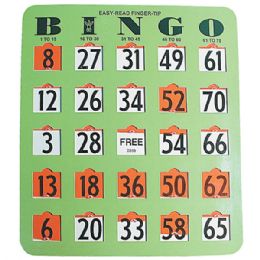









What Are Low Vision Board Games?
A low vision board game consists of the same rules and game pieces as a regular board game, except it is specifically made for people with low vision. The difference can be the game board or the game pieces may be covered with braille, or the game board may have ridges so low vision players can feel where their game pieces are placed. Some game pieces or game boards may have different textures to show the difference, dice may have braille, Bingo cards may be extra-large to be seen more clearly, or Dominoes tiles may have raised spots, or pips. People with low vision like to have fun playing board games and low vision board games can assist them to continue enjoying playing with family and friends.
What is Low Vision?
Low vision can happen to people of all ages, sex, and race, and while an estimated 3.5 to 5 million people in the United States suffer from low vision, adults over the age of 60 are the most affected. Low vision is a visual impairment that is not correctable through surgery, glasses, pharmaceuticals, or contact lenses. An individual’s low vision can be characterized by blurred vision, partial sight, tunnel vision, blind spots, and legal blindness.
A Preparation Checklist to Get Ready to Play Low Vision Board and Card Games
Before users begin a low vision board game, it may be beneficial to try some of the following adaptations first:
It is always a good idea to have strong, bright light when playing table top games, but especially so when playing with people who have low vision. Overhead lighting is acceptable, yet a lamp with an adjustable gooseneck or flex-arm is usually a better choice because the light focus can be adjusted to any direction as required.
Using a low vision device such as a magnifier mounted on a flexible gooseneck stand, or an around-the-neck or chest magnifier can be of assistance to a low vision player.
Having a contrast between the game board and the game pieces can help the low vision player to easier see the outlay of the game. Also, using solid background colors to help make the game board or game piece stand out clearer is better than having a tablecloth covering with prints, patterns or stripes.
Attach labels to the outside of game boxes, game boards and game pieces with tactual labels (review Rehabmart’s Identifiers, Low Vision Aids, Label Maker, Braille for labeling products) to help differentiate games and pieces from one another.
What Are Some Examples of Low Vision Board Games?
Braille games such as Braille Monopoly which has each game space labeled in both print and braille, and also features a special tactile overlay which helps the low vision player to identify and locate all properties.
Extra-large sized Dominoes with raised and colorful spots, or pips that can be easily felt by a low vision player.
Braille Scrabble has braille tiles, a tactile game board, and braille and audio tape instructions.
Large print Bingo cards to help enable low vision players to better see the numbers on the Bingo card. Another Bingo option is the Easy Read Finger-Tip Bingo card which eliminates the use of Bingo markers. Instead, the low vision player can slide down a shutter over the large print numbers.
A low vision chess set is customized for the low vision player in several different ways. The black squares are raised to help distinguish them from the white squares, and a hole is in each square to help keep the pieces steady and in place. A metal tip is added to the black chess pieces to differentiate them from the white pieces.
Brailled dice are oversized dice with large raised black dots which can be seen or felt by low vision players.
Rehabmart is pleased to offer a wide selection of innovative low vision board games from such superior quality vendors as Enabling Devices, MaxiAids, and LSS.
Hulet Smith, OT
Rehabmart Co-Founder & CEO
ws